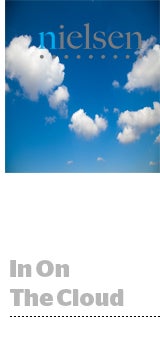 Nielsen predominantly partnered with big marketing clouds à la Adobe to date – until now.
Nielsen predominantly partnered with big marketing clouds à la Adobe to date – until now.
The measurement giant on Tuesday rolled out the Nielsen Marketing Cloud, which is is the company’s first major attempt to unify various homegrown and acquired assets into a single platform for media owners and advertisers.
A number of food and beverage, personal care, wine and spirits and digital media category clients, including Scripps Networks Interactive and National CineMedia, are beta testing the platform.
The Nielsen Marketing Cloud consists of several components. They are the Nielsen data management platform (DMP) and data-as-a-service business through the eXelate acquisition last March; a multitouch attribution system that now leverages the Nielsen DMP; in-flight analytics used by automotive, CPG and retail clients, with integrations to 150 third-party applications the Nielsen DMP inherited from eXelate.
The applications might include programmatic ad servers, email service providers, content management systems and testing platforms (A/B, multivariate similar to Optimizely) and search.
Certain homebuilt systems, such as the cross-platform planning tool Nielsen Media Impact, will be integrated in the following months.
“Exelate sits at the core of this,” said Megan Clarken, president of product leadership, who leads Nielsen’s marketing effectiveness practice and Watch products (media/advertising) segment.
“We’re taking a piece of technology infrastructure and building a really big data engine,” she added. “On top of that, we’ve done some of our own bespoke software development and made [other] acquisitions to support it.”
One example is Nielsen’s recent acquisition of Pointlogic, a media measurement tool that allows advertisers to forecast the impact of media spend on outcomes such as sales and brand equity.
Although the phrase “marketing cloud” is often inclusive of CRM, email or campaign management, Nielsen has no plans to enter that race itself – for now.
“Our data is created from scratch – the most obvious one being media exposure data,” Clarken said. “Will we ever get into CRM or email? I have no idea, because there are terrific datasets out there we can use without going down that route.”
For instance, if a CPG company uses Nielsen Marketing Cloud, it is able to port in first-party CRM data and Nielsen could subsequently identify lookalikes based on its access to third-party datasets.
One example is Nielsen’s new partnership with DISH Network, which will allow it to import set-top box data into its ratings products. Others may include retail datasets at the store or SKU level through its retail measurement platform beyond Nielsen Homescan, the company’s consumer shopping panel.
Developing a unified consumer profile is key for measurement and targeting, for which Nielsen is well positioned to solve, said Martin Kihn, a research VP at Gartner.
But, he added, Nielsen also lacks an execution layer, such as multichannel campaign management and site optimization, a common feature of many other marketing hubs.
Nielsen’s success could hinge on its articulation of a clear strategy around connecting online-to-offline data, cross-device identity and TV data, he added.
Nielsen, however, claims to have a clear handle on its point of differentiation and that’s data neutrality.
“We need to make sure there is a referee on the field between advertisers, agencies and media owners to make sure the media owners are represented by someone who measures the entire marketplace, not just themselves,” Clarken added. “Then on the flip side, buyers and agencies want to know they got what they paid for by a party who’s independent.”













